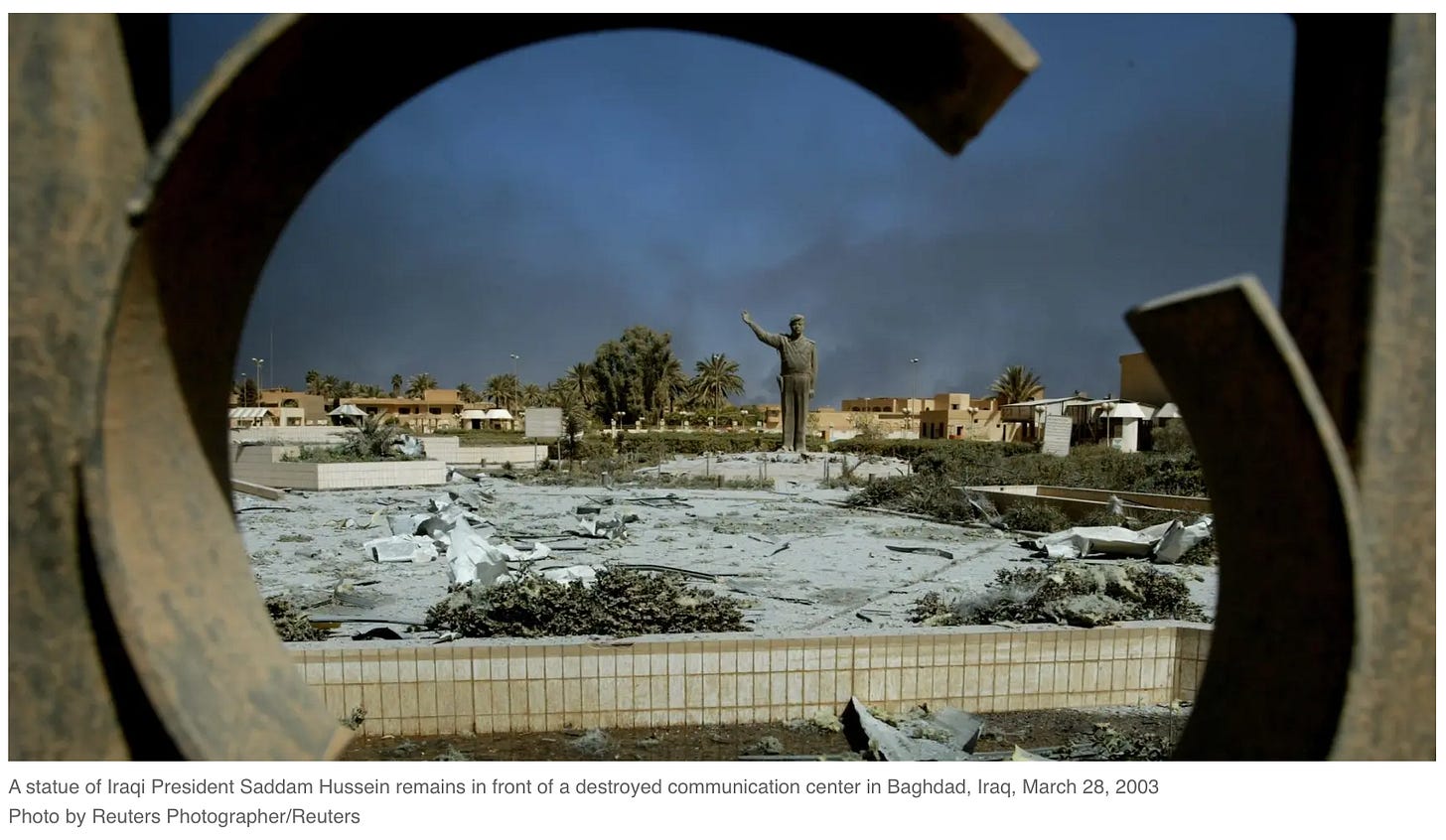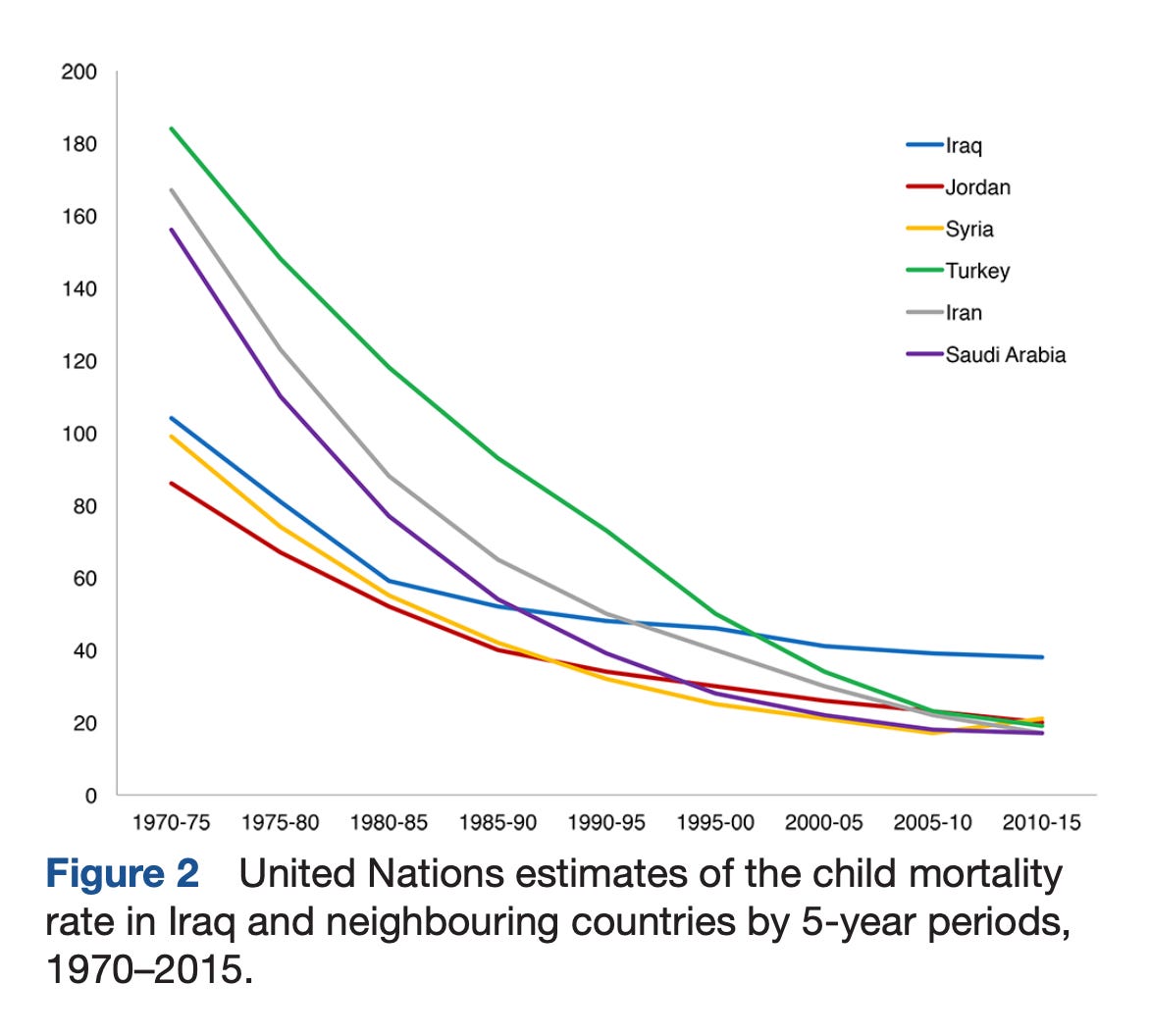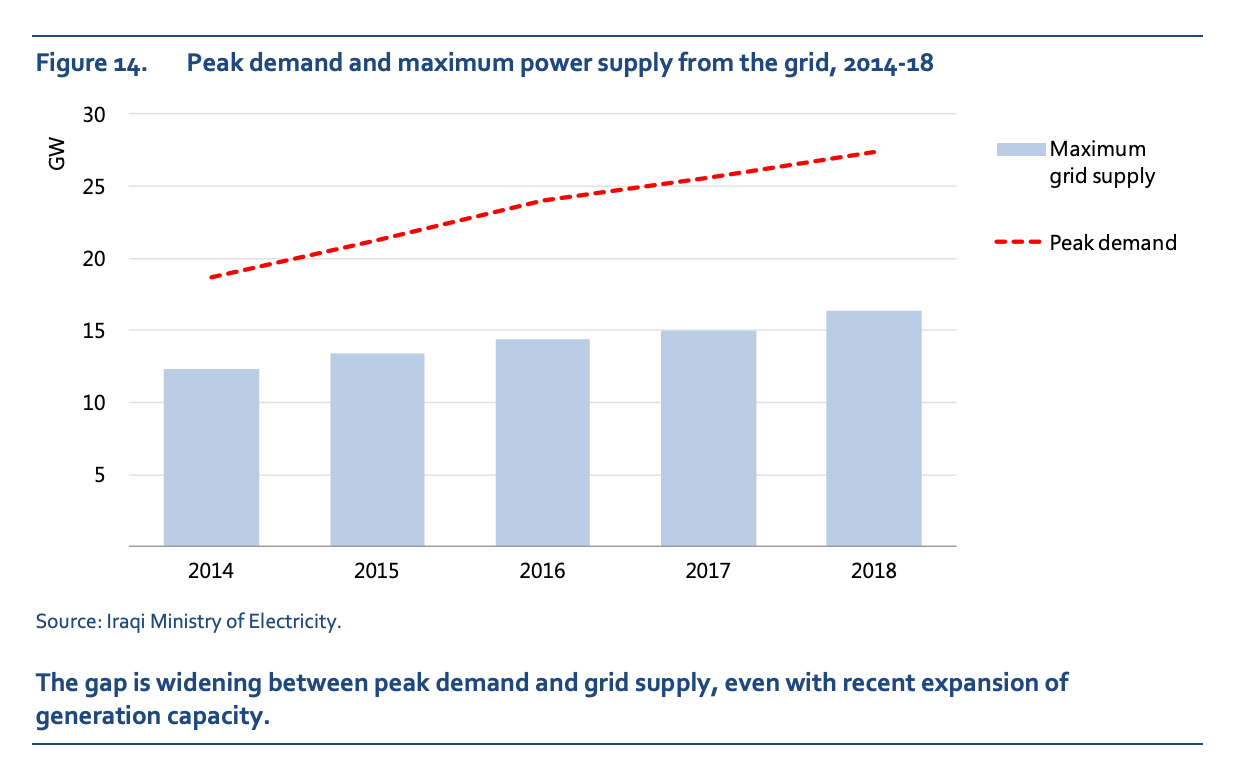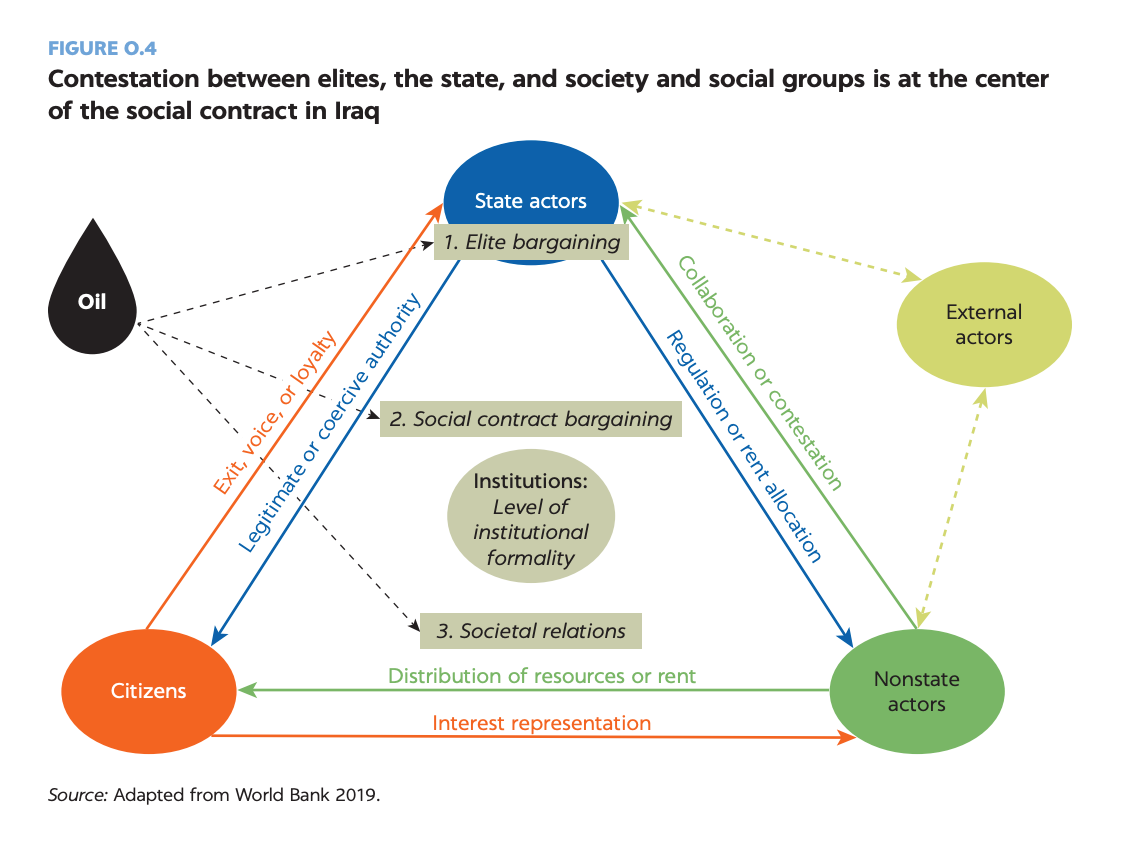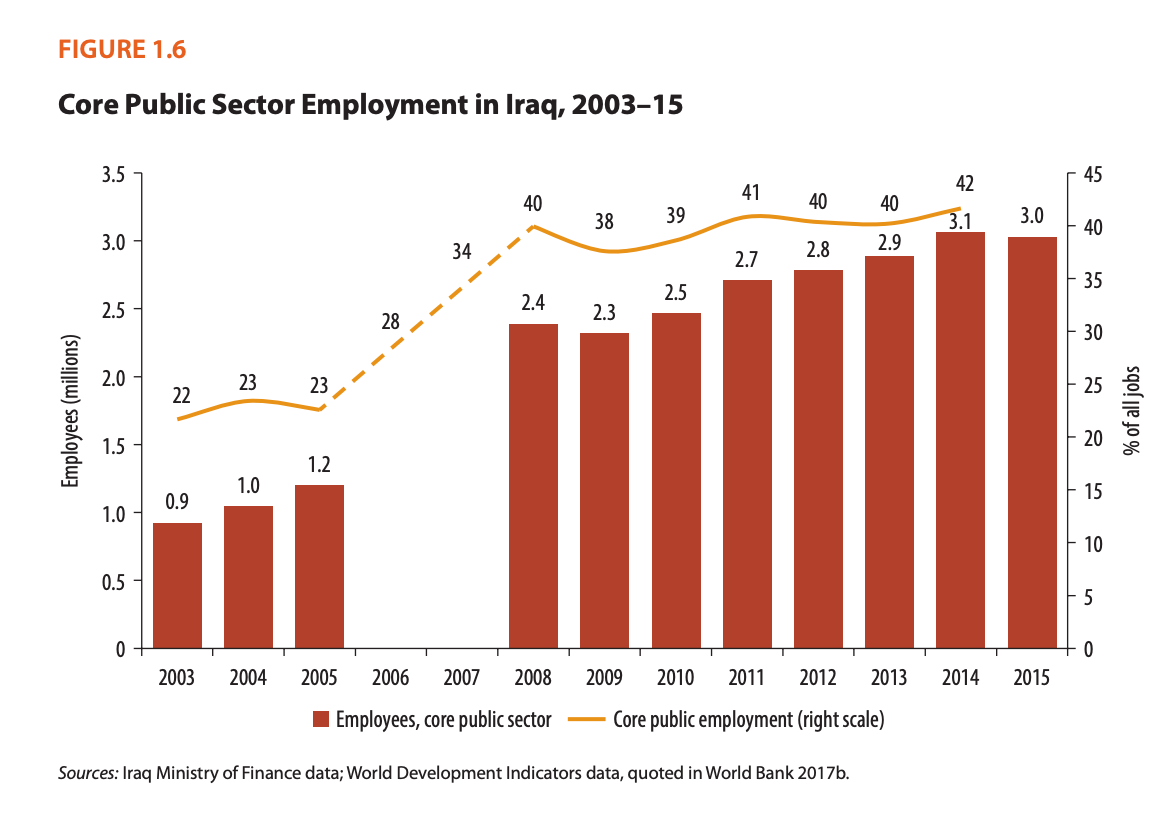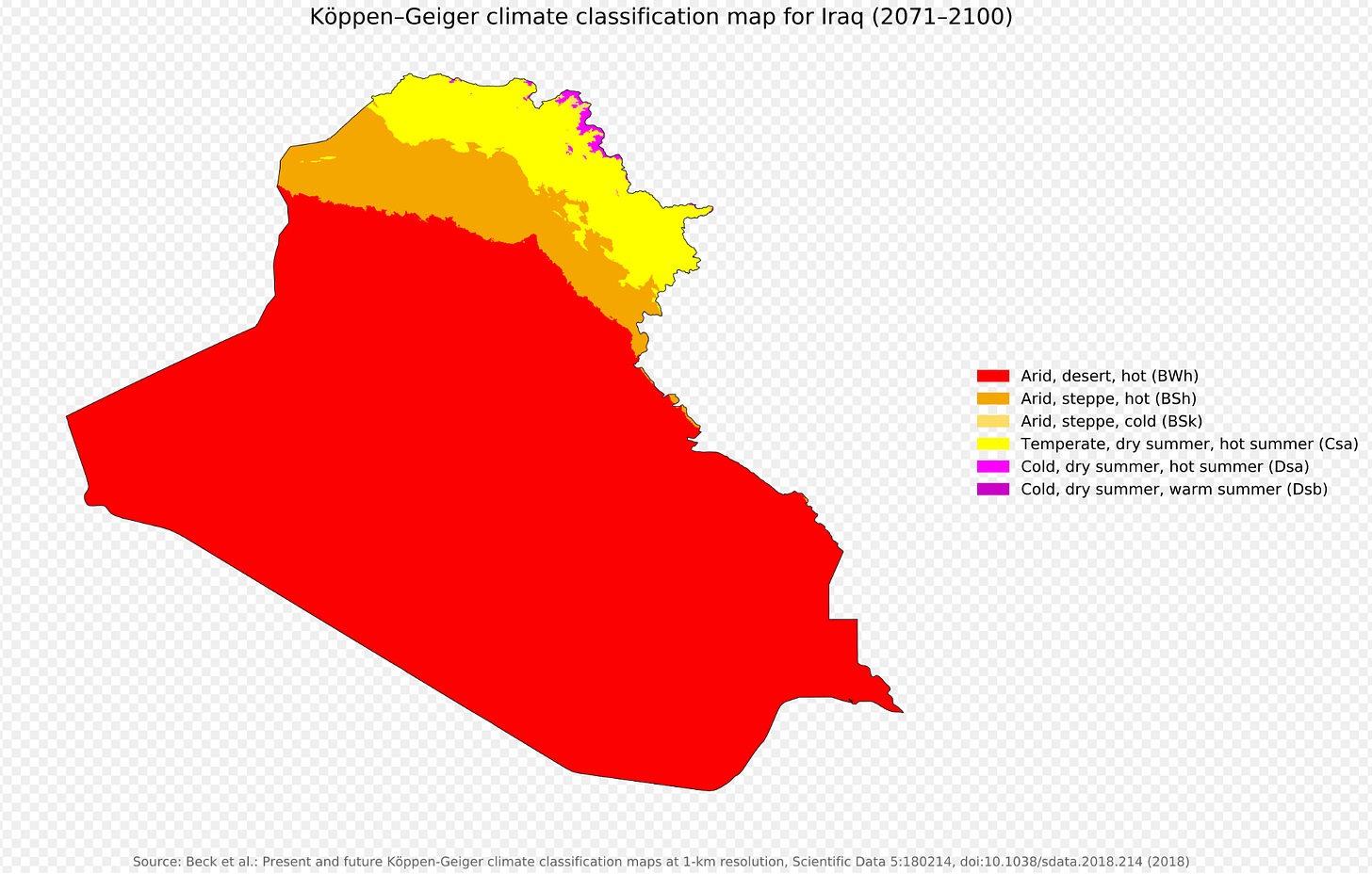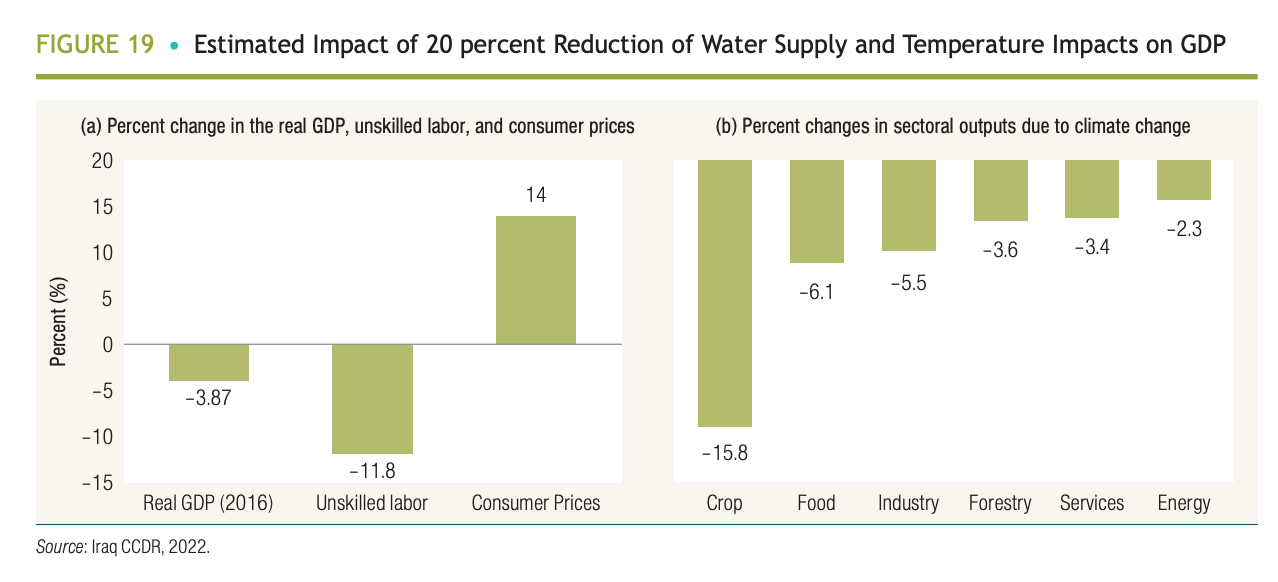Chartbook 204: Iraq's economic impasse twenty years after the invasion.
The 20th anniversary of the disastrous invasion of Iraq by the US-UK coalition demands a reckoning. Cameron and I discussed the legacy of the war on the podcast.
Today, Iraq is often described as a state on the brink of disintegration and social and economic disaster. That fragility does not begin with the 2003 invasion, it is a persistent theme in the history of a territory caught between massive power blocs.
For hundreds of years the Ottomans struggled to maintain their grip over the provinces of Mosul, Baghdad and Basra in the face of challenges from the Mamluks. Between 1915 and 1917 the forces of the British empire took three years to take Baghdad in the bloody Mesopotamian campaign. The Iraqi state created in 1921 under the British mandate struggled, from the start, to impose itself against Kurdish rebellions. In 1941 a pro-German coup, led to a large-scale invasion by allied forces who used Iraq as the base for the occupation of Iran and for defeating Vichy forces in Syria. A giant nationalist uprising against British influence over the country was suppressed in 1948 in the course of the disastrous Arab League campaign against Israel. In the 1950s Baghdad answered Egyptian and Syrian unity with abortive efforts to unify with Kuwait, which left it isolated on all sides. In 1958 a military coup overthrew the Hashemite monarchy and declared a Republic whose political history would henceforth be dominated by various factions of the Baath party. Fighting between Baghdad and Kurdish autonomists continued until the mid 1970s. Saddam Hussein who took power in 1979 not only attacked Iran but escalated the brutal struggle to consolidate Baghdad’s grip on Kurdish and Shia regions of the country.
But, for all this political turmoil, from the 1950s onwards, benefiting from increased oil revenues, Iraq experienced rapid economic, social and cultural development. By the end of the 1980s Iraq was widely seen in the Arab world as a relatively successful oil-fueled developmental state. As a US government report on Iraq put it in June 2003:
In the 1980s, Iraq had one of the Arab world’s most advanced economies. Though buffeted by the strains of the Iran-Iraq war, it had – besides petroleum -- a considerable industrial sector, a relatively well-developed transport system, and comparatively good infrastructure. Iraq had a relatively large middle class, per capita income levels comparable to Venezuela, Trinidad or Korea, one of the best educational systems in the Arab world, a well educated population and generally good standards of medical care.
In 1990 that upward-directed trajectory of development was broken. Iraq entered a period of violence and frustrated development that continues down to the present. In 2020 a World Bank report reached the following sobering conclusion:
Although oil wealth has allowed Iraq to obtain upper-middle-income status, in many ways its institutions and socioeconomic outcomes more closely resemble those of a low-income, fragile country. The Iraqi education system once ranked near the top of the Middle East and North Africa (MENA) region, but it now sits near the bottom. Iraq’s rate of participation in the economy is also low, and the country has one of the lowest female labor force participation rates in the world, low levels of human and physical capital, and deteriorating business conditions. Iraq also has one of the highest poverty rates among upper-middle-income countries.
Understanding this trajectory - from modernization champion to fragile low-income society - is crucial to plumbing the depths of the Iraqi crisis. It is all the more striking because Iraq, as a major oil exporter should by-rights have profited from the oil boom of the 2000s and 2010s to catapult itself squarely into the higher middle income bracket of global development. It was not to be. Instead Iraq’s development was derailed by war, sanctions, invasion and civil war. And Iraq’s crisis has spilled over its borders and merged with a polycrisis afflicting Western Asia.
Saddam’s attack on Iran in the early 1980s indicated his violent ambition, but as far as Iraq’s economy is concerned it was the invasion of Kuwait in August 1990 and the US-led riposte that delivered the first devastating shock. After a measure of recovery under the more relaxed sanctions regime of the late 1990s, the invasion of 2003 delivered another devastating blow to the economy and unleashed a phase of insurgency, civil war and state disintegration. This is best tracked by the bloody graph of civilian casualties.
Source: Iraq Body Count
This the narrowest measure of casualties: only those deaths attributable directly to violence. Broader estimates of excess deaths add hundreds of thousands to the death toll.
Amidst insecurity and chaos, Iraq was unable to profit substantially from the spectacular oil boom of the early 2000s. Despite sky-high prices it was only after 2010 that Iraq’s oil production exceeded the peaks of 1989 and 2002.
World Bank 2022
And the stabilization after 2010 was to prove temporary. In 2014 two shocks came together. Oil prices plunged, just as the ultra-extremist Daesh movement swept across Northern Iraq and Syria. Having dissolved Saddam’s army, America had been forced to spend $20bn to rebuild Iraq’s security forces. But the demoralized troops proved no match for the radical insurgents. ISIS took control of a huge swath of territory, forcing the mobilization of an international coalition. Tellingly this was anchored not only on a rebuilt Iraqi security forces, but on the autonomous region of Iraqi Kurdistan. Not until 2017 was the ISIS threat brought under control.
The war against ISIS came at a huge price. In the worst months of 2014 civilian casualties were greater than in 2003 or at the time of the civil war. The economic damage was no less severe. As the World Bank comments:
The country’s per capita GDP is about 18–21 percent lower in 2018 than it would have been if not for the conflict beginning in 2014. In particular, although Iraq’s oil GDP grew steadily during the conflict, the country’s non-oil GDP is estimated to be about 33 percent lower in 2018 than it would have been without the conflict (figure O.2) and has fallen below its peers (figure O.3).
The defeat of ISIS has brought a degree of calm. In terms of military conflict, Iraq is now more quiet than it has been at any time since 2003. This yields a significant peace dividend for economy and society. But the cumulative damage is dramatic. On a purchasing power parity basis, GDP per capita in Iraq today is barely higher than it was in 2003.
One powerful way to summarize the derailment of Iraq’s development is the rate of infant mortality, a basic measure of human welfare, sanitary conditions and medical provision. As Dyson Cetorelli 2017 argue, Iraq’s infant mortality data are contentious, having been instrumentalized by Saddam’s regime in the 1990s in the PR campaign against sanctions. But the following data paint a grim enough picture.
In the 1970s and 1980s Iraq was amongst the most advanced Arab countries. Since the 1990s this crucial indicator of human well-being has stagnated. As a result, Iraq’s infant mortality rate is today only marginally lower than it was in the 1980s and is twice those of all its neighbors. This is the depressing legacy of Saddam Hussein’s violence, the disastrous aggression of the United States and its allies and the failure of Iraq’s political elites to build an alternative to the Baathist state.
The state of Iraqi public health is indicative of broader dysfunction. Electricity, water supply and education, all of which were once symbols of Iraqi modernization, are now profoundly fragile. Improvements continue. Enrollment in elementary education, for instance, is higher than ever before. But the process of development is slow, erratic and lags far behind comparable societies.
One telling area of crisis is Iraq’s dilapidated electricity supply. Despite being an energy producer of global stature, Iraq’s domestic power supply lags chronically behind demand. Blackouts and load shedding are a daily routine.
Source: IEA
Resourceful Iraqi households and businesses make up for the shortfall through expensive and inefficient improvisation:
Small-scale oil-based generators play a critical role in supplementing grid supply, helping to alleviate some of the most acute shortages in the peak summer months. In 2018, the combined total of small generators was 5 GW. About two-thirds of the total are privately owned and referred to as neighbourhood generators, with direct connections provided to paying households and businesses. About one-third of the small generators are owned by government entities, mainly to meet their own electricity needs. Together, these assets close half of the gap between peak demand and grid supply. But they are an extremely expensive option for consumers. …. Supplementing its grid supply, for an average of around 10 hours per day over the year, this household (upper middle-class) might expect to pay as much as USD 4000 per year to the neighbourhood generator. … fixed charges translate to around USD 1 000 per MWh for the example household, putting them among the most costly sources of electricity anywhere in the world.
The failing power supply is one strand in a network of constraints crippling Iraq’s potential growth. As the World Bank concludes:
Iraq’s GDP per capita could be up to 60 percent higher if it had the same levels of labor force participation, investment, human capital, and productivity as other upper-middle-income countries. At the moment, Iraq lags behind its aspirational peers on all of these indicators, particularly the labor force participation rate (especially among women). Raising Iraq’s participation rate to the UMIC average would alone increase Iraq’s GDP per capita by almost 31 percent. Raising the investment rate and the quality of the labor force would each also raise GDP by about 13 percent.
But, as the World Bank continues: “to achieve these outcomes, Iraq would need to implement reforms with payoffs farther in the future than its ruling elites have yet shown interest in.” And one can be under no illusions about the political and social forces that overdetermine the disastrous status quo. As the World Bank experts remark, the destruction of the Baathist state by the occupation authorities after 2003 created a dangerous vacuum:
Iraq’s current political settlement, which rests on rent-sharing and powersharing by political parties, has led to elite capture, widespread clientelism and patronage, and political paralysis. The post-2003 political system in Iraq grew out of an elite pact built on ethnic and sectarian identities. In its early years, the process of de-Ba’athification and the dissolution of the Saddam-era army led to an erosion of the country’s existing bureaucratic infrastructure and displaced the senior civil service that had run it. As time went on, the process of elite politics shifted from sectarian and ethnic power-sharing to political party–based power-sharing and polarization, in which contestation and negotiation take place over control of the formal bureaucracy. Politicizing appointment for key bureaucratic posts became a fundamental component of how political parties extended their patronage networks to strengthen their legitimacy, power, and wealth (Dodge 2019). Furthermore, the increasing fragmentation of Iraq’s political landscape has led to political instability and paralysis and fueled fragility.
The World Bank provides a map of these multiple and interlocking trade-offs:
This fraught political economy manifests itself is the hypertrophy of the Iraqi state apparatus. Even under Saddam the private sector was underdeveloped. But since 2003, as the state has disintegrated and its functions have deteriorated, the public sector has effectively become the employer of last resort: “Between 2003 and 2015, the core public sector expanded from 900,000 employees to more than 3 million, providing approximately 42 percent of all jobs. Public employee salaries became the largest expenditure item in the government budget.” The ironic legacy of the destruction of the Baathist state is to have created in Iraq a far larger and far more dyfunctional edifice.
Not only is the public sector payroll inflated by factional rent-seeking. Control of key institutions like the central bank is parceled out between major factions based on religious and regional ties (Shia and Sunni), personal loyalties and connections to powerful paramilitary grouping (Sadr v. the Coordination Framework), more and less beholden to Iran. Meanwhile, billions of dollars are looted from the coffers of the state, most recently a giant $2.5 billion heist that implicates top-level figures across several Shia factions. Even Iraqi Kurdistan, which was once the poster child of Iraqi recovery, is now at a serious impasse, as the in-depth report by By Winthrop Rodgers in Foreign policy spells out.
Can anything break the deadlock?
The Financial Times in its op ed on the occasion of the anniversary points to the fact that “60 per cent of the population are aged under 25 and they will, one day, drive change”. But, at what price. As the paper points out, when “frustrated young Iraqis took to the streets in 2019, more than 600 protesters were killed. At the latest parliamentary election, in 2021, just 36 per cent of eligible voters cast a ballot, a damning indictment of Iraqis’ despondency. It is not uncommon to hear Sunnis and Shia complain that life was better under Saddam.”
The World Bank also points to structural conditions for potential future growth rather than specific political coalitions that might lead such a breakthrough. The Bank hails the peace dividend. And it points to the obvious and huge opportunities in the agricultural sector. That however raises the question of climate change that hangs over Iraq.
As the World Bank comments: Iraq is among the countries most vulnerable to climate change both in physical and financial terms. Over the next half century, on the current climate trajectory the vast majority of the country will be reduced to a parched desert subject to peak temperatures that will be barely inhabitable.
For the Iraqi population and their livelihoods this has drastic implication. As the World Bank remarks:
Reduced water availability and quality degradation impose significant risks on Iraq’s agri-food systems and hence on the ability to diversify the economy. Water scarcity negatively affects GDP and other sectoral outputs, including crops which lower the demand for unskilled workers. Extreme heat temperature adversely impacts (unskilled) labor productivity, which further intensifies the socio-economic challenges associated with climate change.
The implication is that on top of all its other problems, Iraq does not have time on its side. The thirty years of lost development since 1990 may turn out to have catastrophic implications in the decades to come.
***
Thank you for reading Chartbook Newsletter. It is rewarding to write. I love sending it out for free to readers around the world. But it takes a lot of work. What sustains the effort are voluntary subscriptions from paying supporters. If you are enjoying the newsletter and would like to join the group of supporters and receive the full Top Links emails several times per week, click here:


